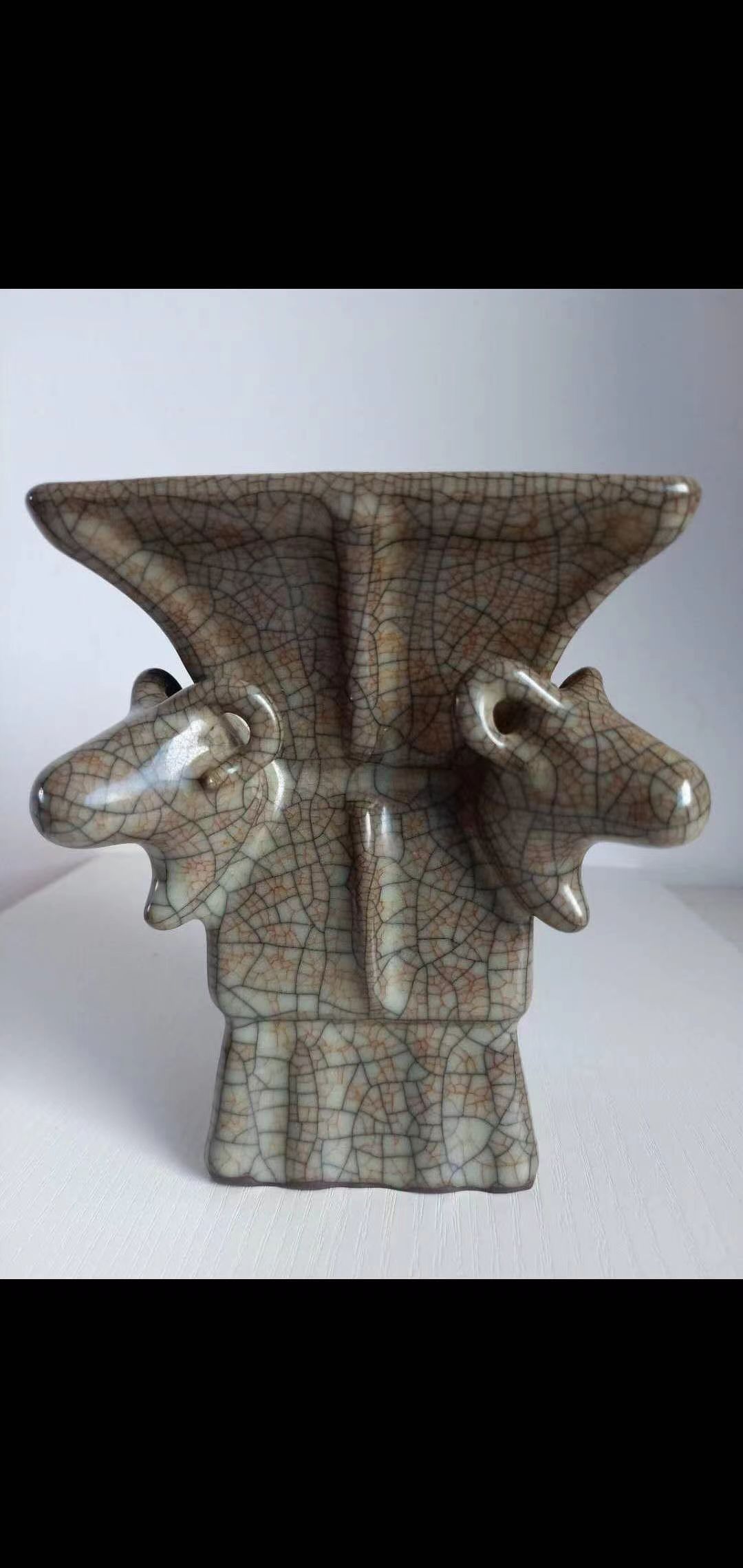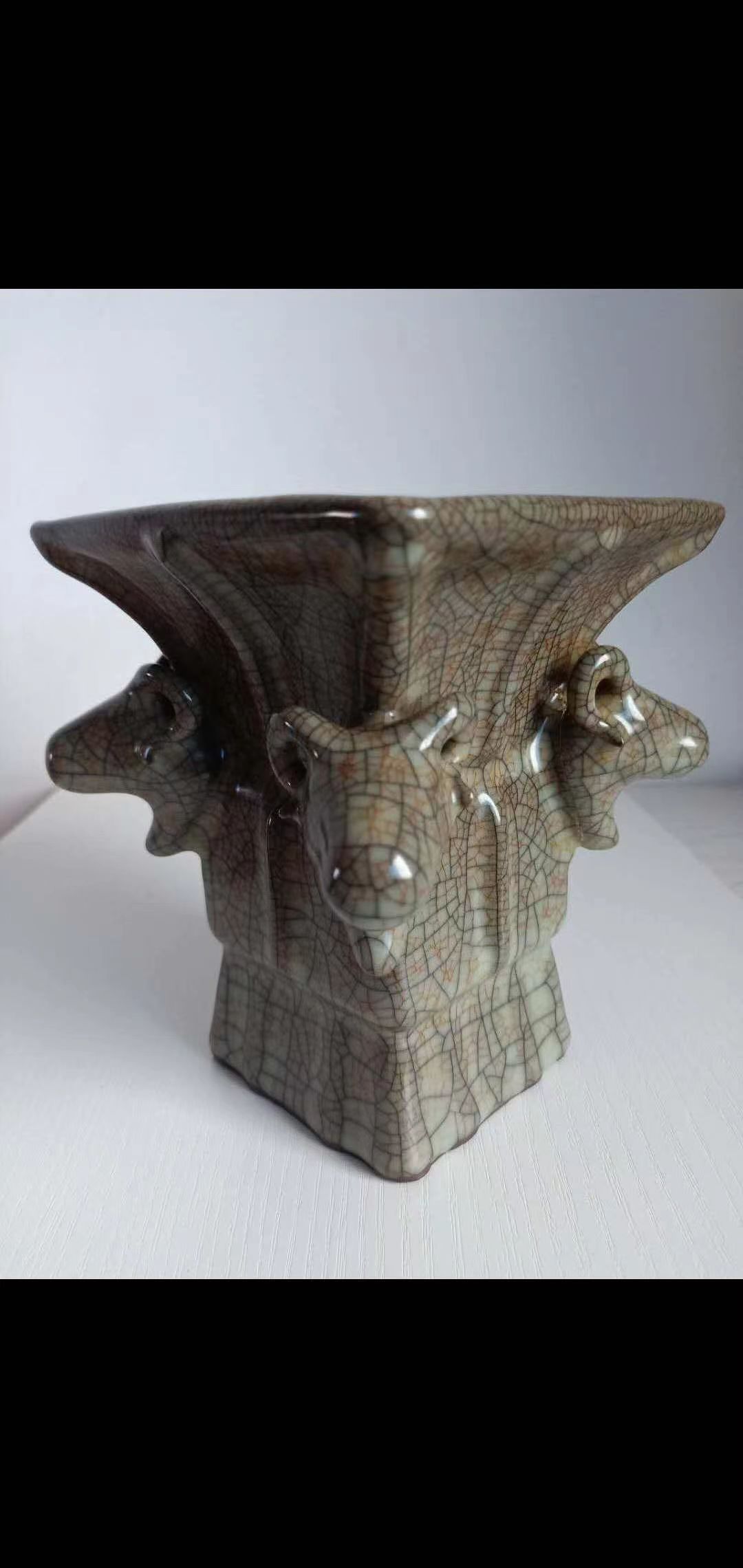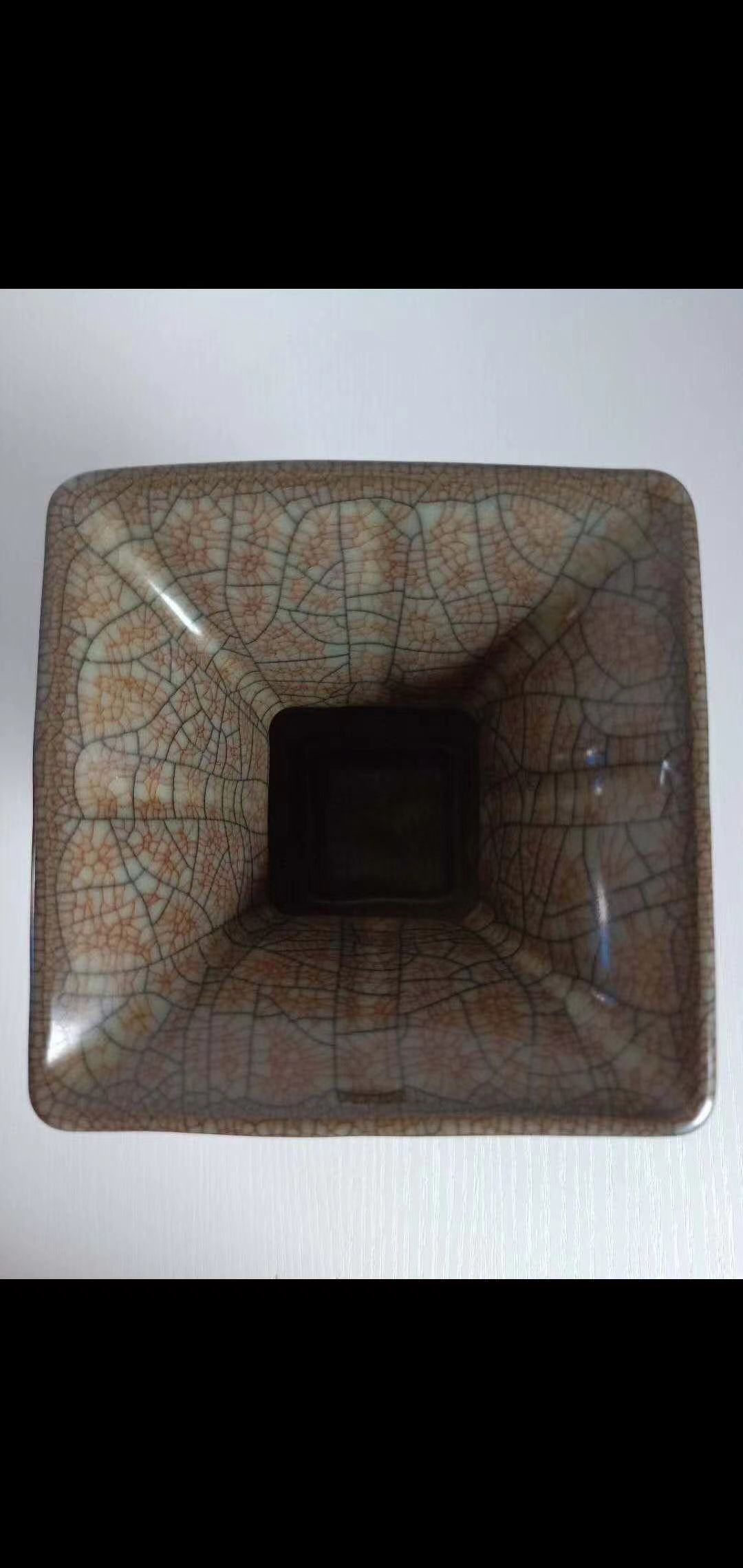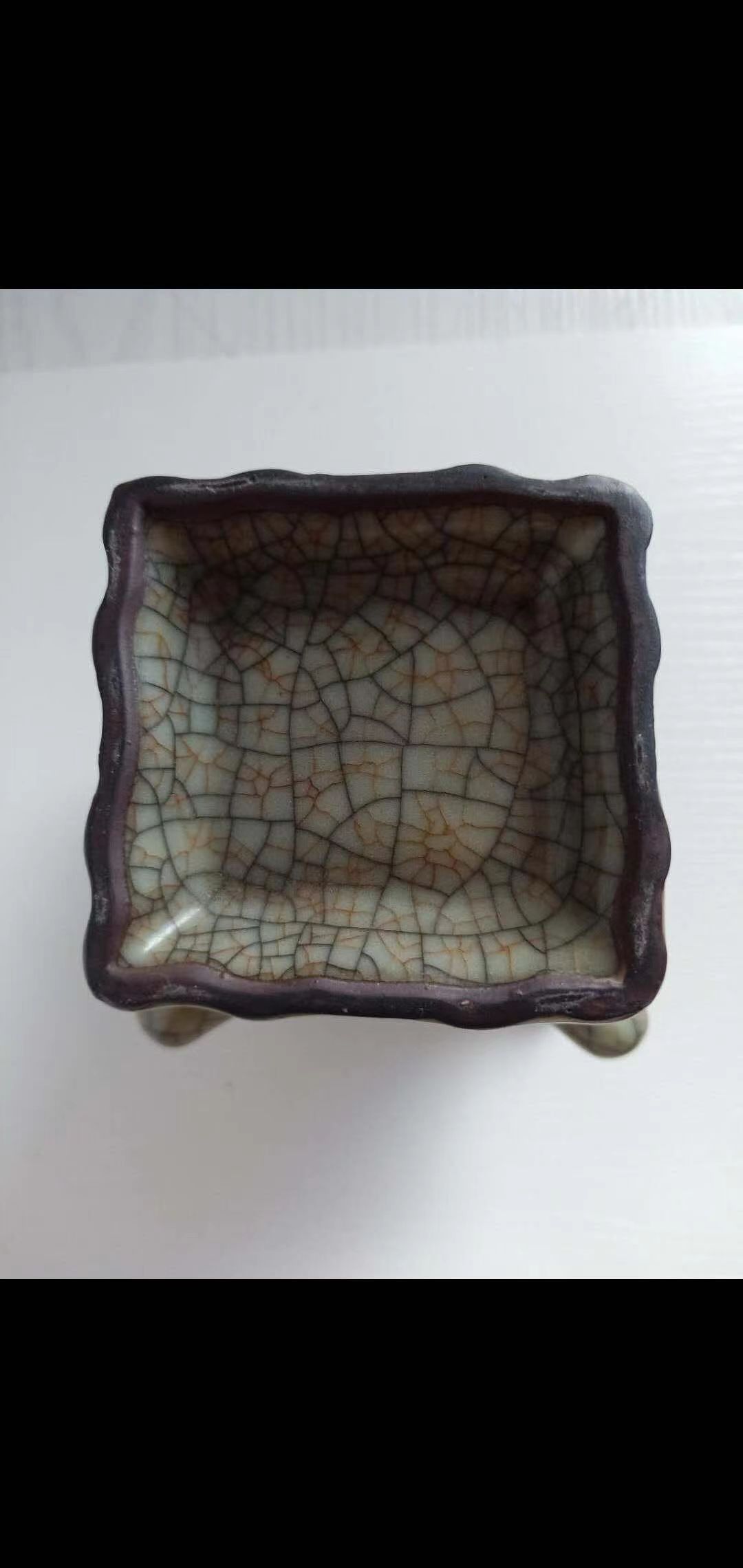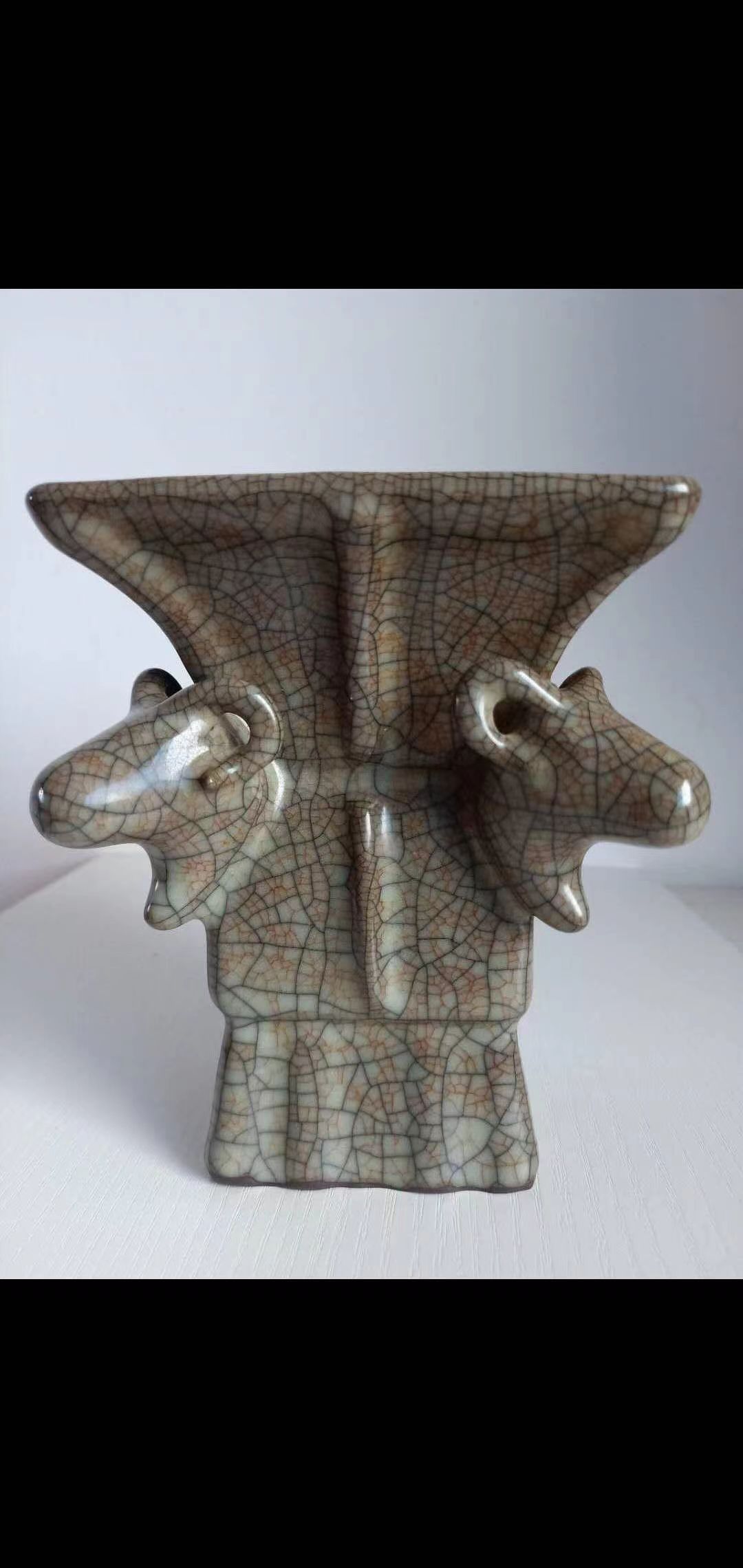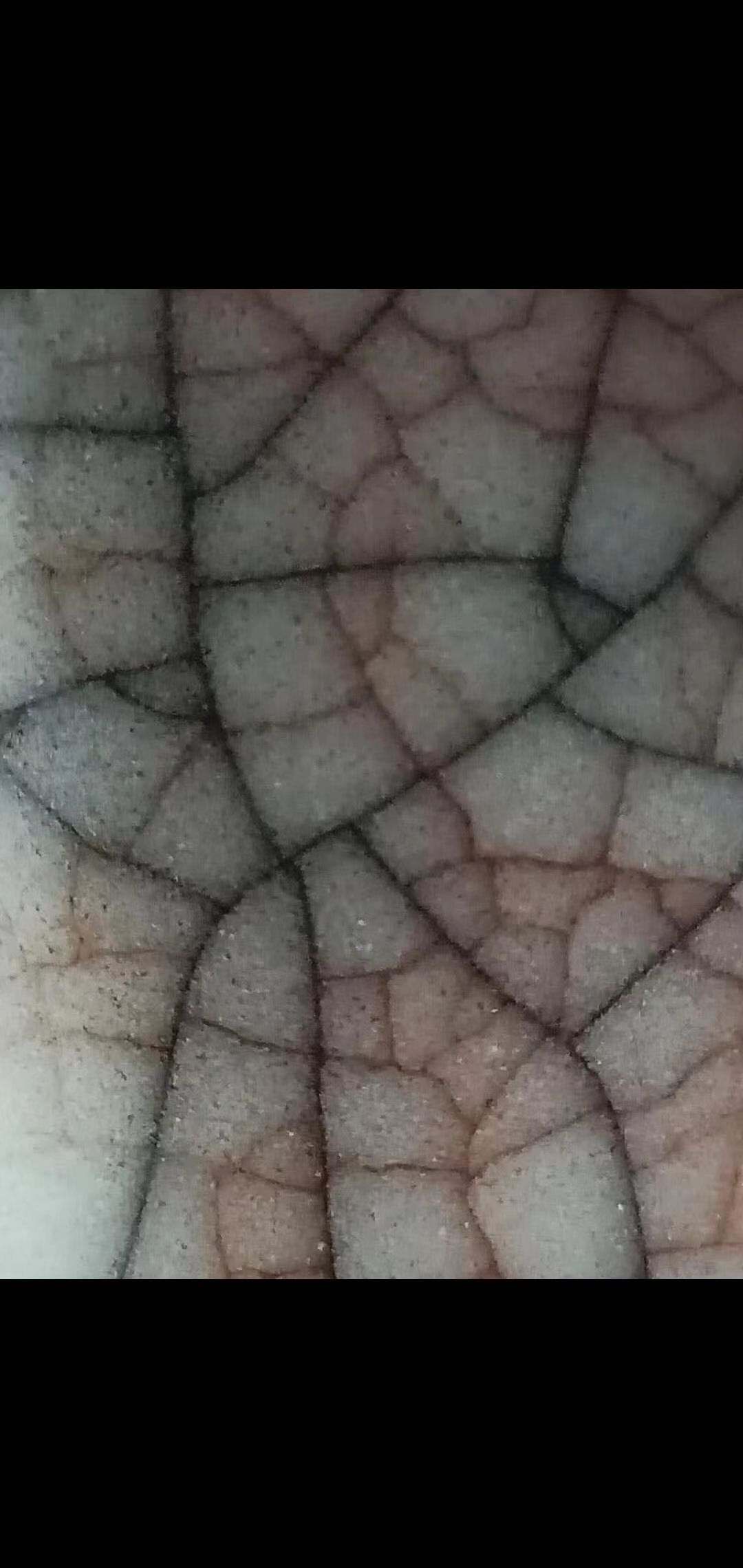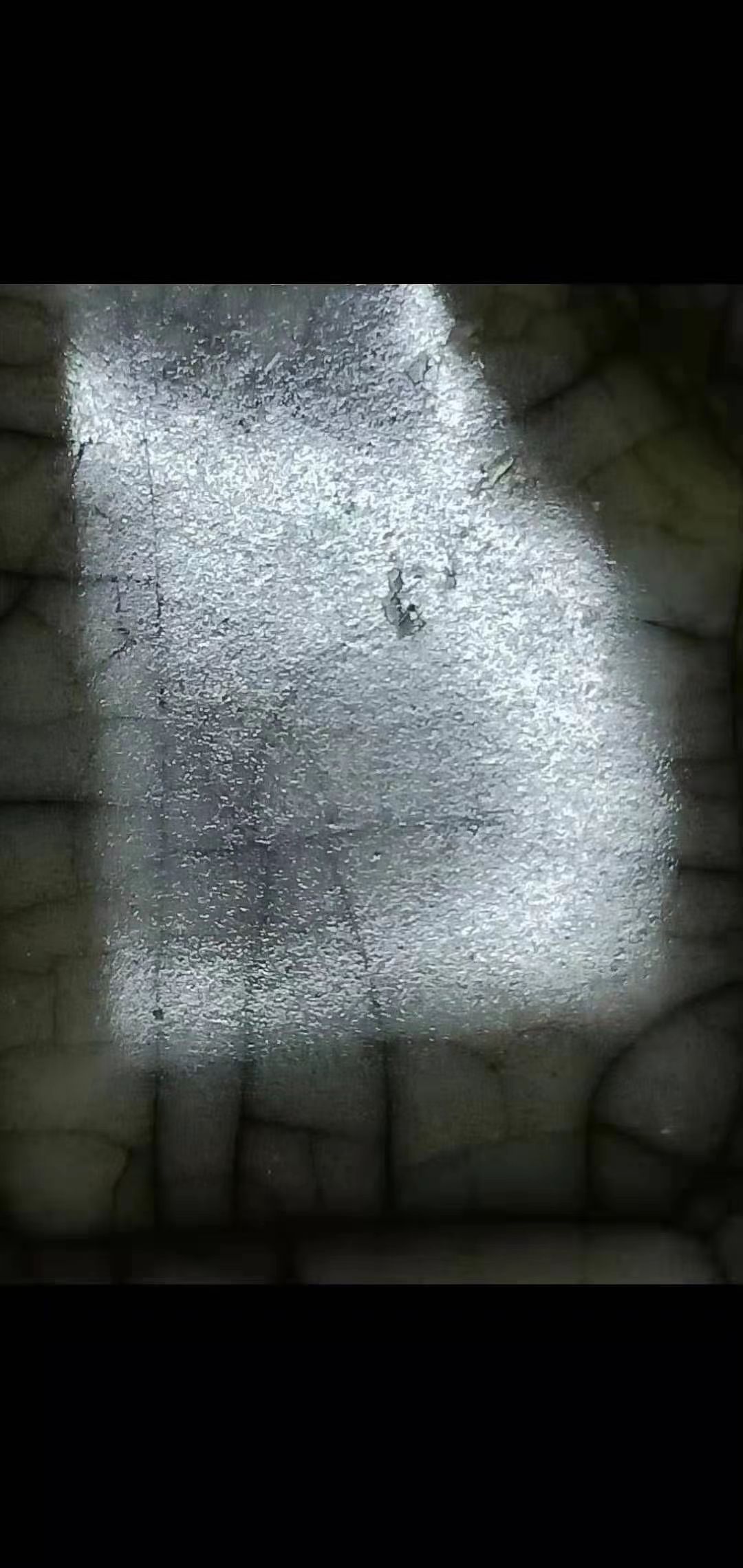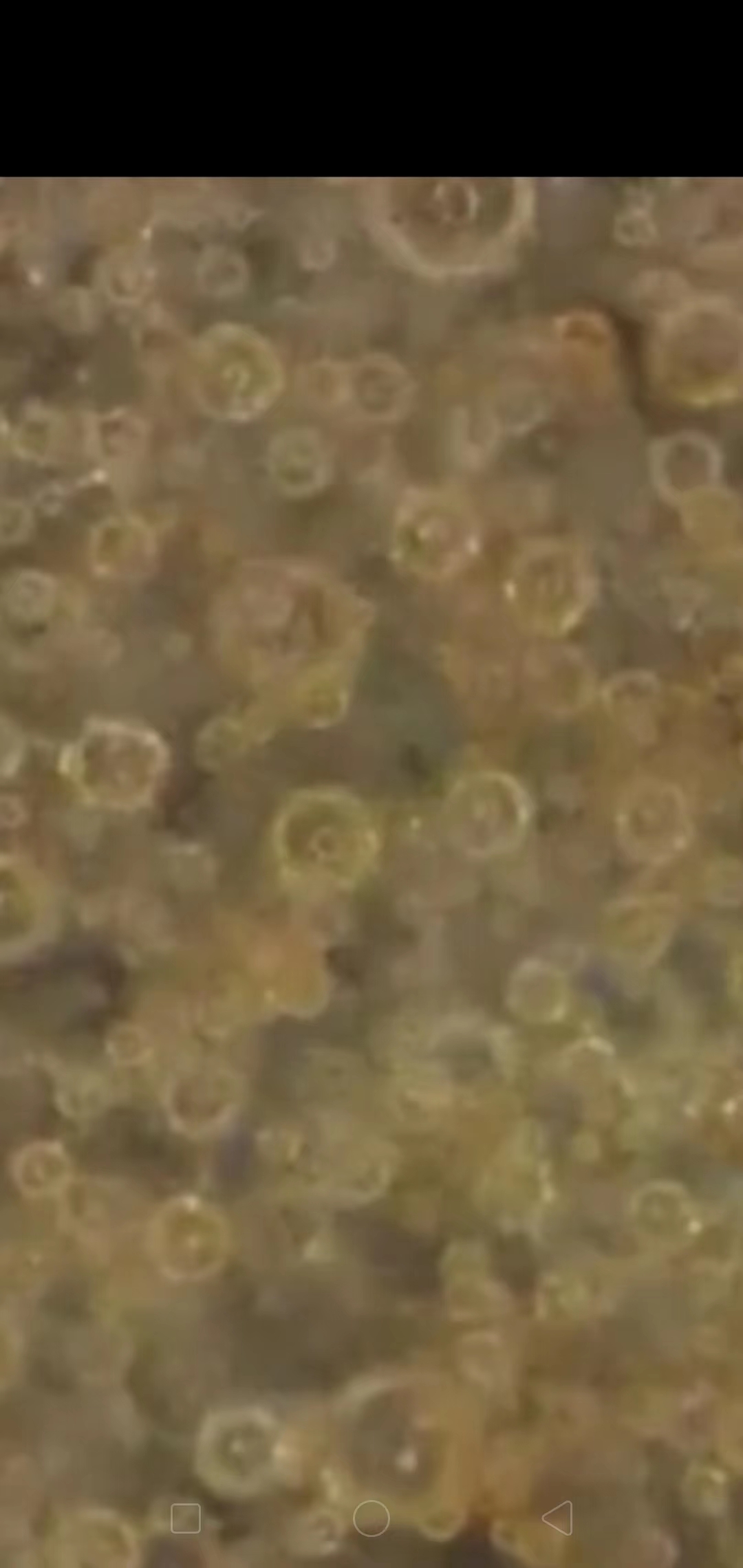“哥窑”名列宋代五大名窑,在陶瓷史上有举足轻重的地位。哥窑胎多紫黑色、铁黑色、也有黄褐色。釉为失透的乳浊釉,釉面泛一层酥光,釉色以炒米黄、灰青多见,釉面大小纹片结合。经染色后大纹片呈深褐色,小纹片为黄褐色,也称‘金丝铁线’“墨纹梅花片”“叶脉纹”‘文武片’等。这是传世哥窑的主要特征之一。哥窑器形有各式瓶、炉、尊、洗及碗、盆、碟等。多见仿古造型,底足制作不十分规整,釉面常见缩釉和棕眼。
与哥窑相关的文字最早见于元至正二十三年(1363年)孔齐的《至正直记》:“乙未冬在杭州时,市哥哥洞窑者一香鼎,质细虽新,其色莹润如旧造,识者犹疑之。会荆溪王德翁亦云,近日哥哥窑绝类古官窑,不可不细辨也。”一般认为,这里指的哥哥洞窑和哥哥窑即为哥窑,“绝类古官窑”也正与以后的文献描述的哥窑特征相符。其后明代《宣德鼎彝谱》说:“马祖之神供奉狮首马蹄炉,仿宋哥窑款式,炉高五寸六分……”,此文多处提到“仿宋哥窑款式”,因此哥窑被认为是宋代的名窑是顺理成章的。
现今发现的真正论及哥窑最早的文献当推明代陆深《春风堂随笔》:“哥窑,浅白断纹,号百圾碎。宋时有章生一、生二兄弟,皆处州人,主龙泉之琉田窑,生二所陶青器纯粹如美玉,为世所贵,即官窑之类,生一所陶者色淡,故名哥窑。”陆深,字子渊,上海人,弘治十八年进士,卒于嘉靖二十三年(1545年)。文中明确了哥窑烧造于龙泉的琉田,琉田今名大窑,为龙泉窑的中心产区。然而明万历十九年(1591年)高濂的《遵生八笺》又有别论:“官窑品格大率与哥窑相同……二窑烧造种种未易,悉举例可见,所谓官者,烧于宋修内司中,为官家造也,窑在杭之凤凰山下……哥窑烧于私家,取土俱在此地。官窑质之隐纹如蟹爪,哥窑质之隐纹如鱼子,但汁料不如官料佳耳……”,文中“取土俱在此地”已将哥窑产地定为杭州。这一前一后的两种说法,是明代文献中最典型的关于哥窑的“产地说”。
明末和清代,论及哥窑的文献越来越多,但多为抄录诠释前人著作的产物,沿袭《春风堂随笔》和《遵生八笺》之说。然而对于哥窑器物特征的描述倒是越来越具体,越来越清晰。综合各类文献资料,哥窑的特征为:胎色黑褐,釉层冰裂,釉色多为粉青或灰青。由于胎色较黑及高温下器物口沿釉汁流泻而隐显胎色,故有紫口铁足之说;釉层开片有粗有细,较细者谓之“百圾碎”。根据文献提供的线索,人们在浙江龙泉的大窑和溪口找到了生产类似器物的窑址。其产品为黑胎开片,釉色以粉青和灰青为主,单色纹线,应为入土所致,用垫饼垫烧。上述特征及烧造年代均与文献所述完全相符。至此,宋代五大名窑的哥窑已成定论,其烧造年代为南宋中晚期,产地为浙江龙泉。
然而,不久后人们发现了一类与哥窑特征相符的,而与龙泉产的哥窑特征有别的器物。此类器物亦为黑胎开片,紫口铁足,但其釉色多为炒米黄,亦有灰青;纹线为黑黄相间,俗称“金丝铁线”;用支钉支烧,器型亦不同。由于此类器物仅故宫博物院、上海博物馆、台北故宫博物院等有少量收藏,而不见于墓葬出土,故被称为“传世哥窑”,而称龙泉所产为“龙泉哥窑”。20世纪90年代起,人们对传世哥窑进行深入研究,但由于传世哥窑的窑址无踪可觅,对其性质及年代一时难有定论。一种观点认为,传世哥窑应为文献所述南宋修内司官窑。其理由是,根据南宋顾之荐《负暄杂录》所述理解,修内司官窑产品质量优于郊坛下官窑,但修内司官窑到今无影无踪,更无从知晓其产品面目,而现有实物资料仅有传世。
明末和清代,论及哥窑的文献越来越多,但多为抄录诠释前人著作的产物,沿袭《春风堂随笔》和《遵生八笺》之说。然而对于哥窑器物特征的描述倒是越来越具体,越来越清晰。综合各类文献资料,哥窑的特征为:胎色黑褐,釉层冰裂,釉色多为粉青或灰青。由于胎色较黑及高温下器物口沿釉汁流泻而隐显胎色,故有紫口铁足之说;釉层开片有粗有细,较细者谓之“百圾碎”。根据文献提供的线索,人们在浙江龙泉的大窑和溪口找到了生产类似器物的窑址。其产品为黑胎开片,釉色以粉青和灰青为主,单色纹线,应为入土所致,用垫饼垫烧。上述特征及烧造年代均与文献所述完全相符。至此,宋代五大名窑的哥窑已成定论,其烧造年代为南宋中晚期,产地为浙江龙泉。
然而,不久后人们发现了一类与哥窑特征相符的,而与龙泉产的哥窑特征有别的器物。此类器物亦为黑胎开片,紫口铁足,但其釉色多为炒米黄,亦有灰青;纹线为黑黄相间,俗称“金丝铁线”;用支钉支烧,器型亦不同。由于此类器物仅故宫博物院、上海博物馆、台北故宫博物院等有少量收藏,而不见于墓葬出土,故被称为“传世哥窑”,而称龙泉所产为“龙泉哥窑”。20世纪90年代起,人们对传世哥窑进行深入研究,但由于传世哥窑的窑址无踪可觅,对其性质及年代一时难有定论。一种观点认为,传世哥窑应为文献所述南宋修内司官窑。其理由是,根据南宋顾之荐《负暄杂录》所述理解,修内司官窑产品质量优于郊坛下官窑,但修内司官窑到今无影无踪,更无从知晓其产品面目,而现有实物资料仅有传世。
作为五大名窑之一的哥窑,随着文献资料的不断发现和考古资料的不断充实,对哥窑的认识已渐趋清晰。然而;由于缺乏同代文献,且后代文献常是一鳞半爪,零零碎碎,有的还互相矛盾,仍无法揭开层层面纱,呈现它的真实面目。虽然数十年来与哥窑相关的考古实物资料不断增多,并且也依据这些实物资料解决了一些悬而未决的问题,但在惊喜之后,蓦然回首,人们发现,这些实物资料以及由此而得出的结论往往与文献记述无法对应,有些甚至南辕北辙。因此,哥窑问题依然迷雾重重。哥窑恰如一颗色彩绚丽光芒四射的夜明珠,人们只能远望它耀眼的光环,而无法目睹它真实的风采。
近年来,由于我国加大了对文化产业的重视,导致艺术品的身价水涨船高,珍稀的艺术品其市场热门度,成交率都非常不错。投资艺术品也成为众多投资者的第一选择。所以无论从收藏角度还是经济价值角度来看,该件藏品都十分值得入手.
The item is marked as: Four Sheep Zun with Gold Wire and Iron Wire. The Ge kiln gold wire iron wire four sheep statue was provided by collector Mr. Zhang, and its design inspiration comes from the bronze four sheep square statue unearthed in the late Shang Dynasty. This collection is well preserved, with first-class appearance, natural opening, and natural dyeing of gold wire and iron wire. The overall design is simple and elegant, and the details are also meticulously crafted.
"Ge Kiln" is listed among the five famous kilns of the Song Dynasty and holds a pivotal position in the history of ceramics. Ge kiln tires are mostly purple black, iron black, and sometimes yellow brown. The glaze is opaque and opaque, with a layer of crispy luster on the surface. The glaze color is mostly fried rice yellow and gray blue, with a combination of small and large patterns on the glaze surface. After staining, the large stripes are dark brown, while the small stripes are yellow brown, also known as "golden wire", "ink patterned plum blossom patches", "leaf vein patterns", "civil and military patches", etc. This is one of the main features of the legendary Ge kiln. Ge kiln vessels come in various shapes such as bottles, furnaces, statues, washing bowls, pots, and plates. It is common to see antique shapes, with irregular bottom foot production, and common glaze shrinkage and brown eyes.
The earliest text related to the Ge kiln can be found in Kong Qi's "Zhi Zheng Ji" in the 23rd year of the Yuan Dynasty's Zhizheng era (1363): "During the winter of the Yiwei period in Hangzhou, there was a fragrant cauldron from the Brother Cave Kiln in the city. Although it was thin and new, its color was as shiny as old, and those who knew it were hesitant to recognize it. Wang Deweng of Huijingxi also said that recently, the Brother Cave Kiln was completely similar to ancient official kilns, and it cannot be distinguished in detail." It is generally believed that the Brother Cave Kiln and the Brother Kiln referred to here are the Ge kilns, The "Jue Lei Gu Guan Kiln" is also consistent with the characteristics of Ge Kiln described in later literature. In the later Ming Dynasty, the "Xuande Dingyi Pu" said: "The god of Mazu worships a lion headed horseshoe furnace, imitating the style of Song Ge Kiln, with a furnace height of five inches and six centimeters..." This article mentions "imitating the style of Song Ge Kiln" in many places, so it is natural for Ge Kiln to be considered a famous kiln in the Song Dynasty.
The earliest document discovered today that truly discusses Ge Kiln can be traced back to Lu Shen's "Essays on the Spring Breeze Hall" during the Ming Dynasty: "Ge Kiln, with light white and broken patterns, is known as Bai Garbage Fragment. During the Song Dynasty, there were Zhang Shengyi and two brothers, both from Chuzhou, who were in charge of the Liutian Kiln in Longquan. Their pottery and blue ware were pure as jade and precious to the world, such as official kilns. Those who produced one pottery had a light color, hence the name Ge Kiln. Lu Shen, with the courtesy name Ziyuan, was born in Shanghai and passed the imperial examination in the 18th year of the Hongzhi reign.", He passed away in the 23rd year of the Jiajing reign (1545). The article clearly states that the Ge kiln was fired in Ryuta, located in Longquan. Ryuta, now known as Daiyao, is the central production area of Longquan kiln. However, in the 19th year of the Wanli reign of the Ming Dynasty (1591), Gao Lian's "Zunsheng Bajian" had a different viewpoint: "The character of the official kiln is generally the same as that of the Ge kiln... The two kilns have various difficulties in firing, as can be seen from examples. The so-called official kiln was fired in the Inner Bureau of the Song Dynasty, and it was also built by the official family. The Ge kiln was fired in private households, and the soil was collected here. The hidden patterns of the official kiln are like crab claws, and the hidden patterns of the Ge kiln are like fish roe, but the juice is not as good as the official materials...", The text states that "all soil was taken here" and has designated the origin of Ge Kiln as Hangzhou. These two statements, one before and one after, are the most typical "origin theory" about Ge Kiln in Ming Dynasty literature.
In the late Ming and Qing dynasties, there were more and more documents discussing Ge Kiln, but most of them were products of copying and interpreting previous works, following the theories of "Spring Breeze Hall Essays" and "Zunsheng Bajian". However, the description of the characteristics of Ge kiln artifacts is becoming increasingly specific and clear. Based on various literature and materials,



